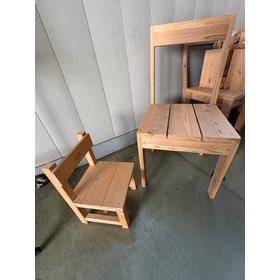Consistent manufacturing from logs to final products.
CLT stands for "Cross Laminated Timber," which is referred to as "cross-laminated timber" in Japanese. It is a wood product made by gluing together layers of boards (lamina) with their fiber directions oriented perpendicular to each other. Developed in Austria in the 1990s, it is a new wood construction material that is now being adopted in buildings across Europe and North America, rapidly gaining popularity. CLT achieves large thicknesses, widths, and lengths that were not possible with existing wood products. It enables the use of wood in large-scale and mid-rise buildings, which were previously difficult to construct with wood, in addition to small-scale structures like wooden houses. High-rise buildings utilizing CLT are being constructed in North America and Europe. In Japan, CLT has also gained attention, with the establishment of the JAS (Japanese Agricultural Standards) manufacturing standards in December 2013, and the announcement and enforcement of building code notifications related to CLT in April 2016. This has initiated the general use of CLT, and mid-rise wooden buildings using CLT have also begun. Our company started manufacturing JAS-compliant CLT in July 2018.
Inquire About This Product
basic information
The product output of the Toyo Industrial Park includes 2,700 m³ of cedar KD foundation and column corners per month, 3,000 m³ of cedar laminated foundations, and 700 m³ of American cypress laminated foundations. Additionally, it manufactures cedar small cross-section structural laminated timber (laminated columns), cedar KD fence materials (for the U.S. market, peaking at 20 containers per month), and cedar KD 2x4 construction lumber (200 to 300 m³ per month). CLT is categorized into species such as cedar, cypress, larch, and cedar-cypress hybrids. The production capacity is 10,000 m³ per year, making it the second largest manufacturing capacity in the country. Furthermore, the CLT processing capacity is 2,000 m³ per year, and basic CLT precut processing (actual size processing, hardware slit processing, drift pin processing, etc.) can be performed in-house. Structural design and construction are outsourced.
Price information
We will examine the design documents for each project, calculate the optimal yield of CLT, and provide you with a price quote. Our company leverages cost advantages and flexible manufacturing capabilities through integrated production from logs to address the expansion of CLT applications and demand. We aim to broaden the possibilities of wooden construction through the promotion of CLT, contribute to the utilization of domestic timber, and foster a positive cycle of wood resources. To achieve this, we first aim to dispel the preconceived notion that CLT is expensive and encourage many people to use CLT.
Price range
P3
Delivery Time
P4
※We calculate the optimal yield for each item and manufacture accordingly.
Applications/Examples of results
CLT panels are a new building material that can be used as structural members and shear walls in wooden frame construction, in combination with reinforced concrete methods, as well as finishing materials for ceilings and floors. They can be utilized in various ways and are suitable for mid-rise and high-rise buildings and large-scale structures where wood has not been widely used until now. They are used in apartments, commercial facilities, schools, and public buildings. Currently, CLT is mainly supplied for non-residential wooden buildings and medium to large-scale wooden projects, but efforts are also being made to develop demand for large wooden warehouses using CLT, as well as for floor surfaces in general residences and RC high-rise buildings. The advantages of buildings using CLT include a shorter construction period since there is no need for the concrete curing time required for reinforced concrete structures. Additionally, CLT can be made lighter than concrete or steel while achieving the same strength (in this case, bending strength), which simplifies foundation work. Compared to concrete and steel, CLT has better insulation properties when compared at the same thickness. The government is also promoting its utilization. Our company is working on expanding the applications and demand for CLT by leveraging cost advantages and flexible manufacturing capabilities through integrated production from logs.
Detailed information
-

Cypress Sunadaya's CLT has a thickness of 90 to 270 mm, a width of 2200 to 3000 mm, and a length of 5000 to 12000 mm. Sizes below this will be cut using our own processing machines. We will calculate your optimal yield from this dimension range and manufacture the final product without waste. The usual thickness of the laminates is 30 mm, but since we have our own sawmill adjacent, custom thicknesses are also possible. The laminate width is 120 to 140 mm. The maximum size of CLT that can be manufactured is 3 m in width and 12 m in length. If the thickness is 90 mm or more, we can accommodate it in increments of 30 mm.
-

The supply capacity of cypress CLT is our strength, and in addition to the standard S90 and S120 strengths, we can consistently manufacture surface configurations using first-class materials and plain small materials for the outer layer. In particular, the surface configuration is well-known for its beauty. The strength classifications are as follows: cedar (same grade configuration) is S60, cypress (same grade configuration) is S90 and S120, cypress-sugi hybrid (symmetrical different grade configuration) is Mx90 and Mx120, and larch (symmetrical different grade configuration) is Mx90.
Company information
About Cypress Sunadaya Cypress Sunadaya Co., Ltd. (Komatsu Town, Saijo City, Ehime Prefecture, Representative Director: Kazuyuki Sunada) established the "Toyo Industrial Park Factory" (Hojyo, Saijo City) in 2018. The new factory has a vast site area of approximately 22,000 tsubo. It integrates new buildings for a lumber mill, a laminated wood factory, a CLT factory, wood drying equipment, and a product warehouse, enabling a consistent manufacturing process from logs to final products.










